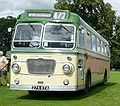Bristol Commercial Vehicles
Bristol Commercial Vehicles was a bus and truck manufacturer from Bristol , England . The company emerged from the Bristol Tramways Company , founded in 1875 by Sir George White , an operator of trams in Bristol. Now renamed the Bristol Tramways & Carriage Company , the first omnibus was manufactured in 1908. Production ended in 1983 when production was relocated to the Leyland Motors factories .
history
In 1908, the first Bristol Tramways & Carriage Company bus was manufactured. In 1931 the company was taken over by the Tilling Group , which controlled the majority of bus operators in Great Britain during the interwar period. From 1948 to the early 1980s, bus transport in Great Britain was largely organized by the state. In 1948, Bristol Tramways & Carriage Company became part of the British Transport Commission , which included the operators of various transport companies. The production of buses was separated from the operation of the bus routes in 1955, separated from the Bristol Tramways & Carriage Company and renamed Bristol Commercial Vehicles . Production of the RE series chassis began in 1962 . At the time, it was common for bus manufacturers to produce chassis that were then body-built by various specialized manufacturers. In 1963 the British Transport Commission became part of the state-owned Transport Holding Company (THC) , which also included Bristol Commercial Vehicles . Leyland acquired a 25% stake in Bristol and ECW in 1965 , which made it possible to sell buses to operators who did not belong to THC . Production of the LH series began in 1967, followed by the VRT series the following year .
In 1969, all English and Welsh bus operators that belonged to THC and British Electric Traction (BET) were transferred to the newly founded National Bus Company . Leyland increased its stake in Bristol and ECW by a further 25% through a share swap, in return the two companies acquired 50% of the shares in the body manufacturer Park Royal Vehicles . Leyland left NBC . To manage the joint venture Bristol , ECW , Park Royal and Leyland National was Bus Manufacturers (Holdings) Ltd. founded.
In 1981, when production of the Leyland Olympian began, production of the VRT and LH chassis was discontinued. In the following year Leyland acquired a 50% stake in Bus Manufacturers (Holdings) Ltd. from NBC . In the same year, production of the RE chassis ends , production at Bristol ceases one year later , the remaining types are manufactured in Leyland's plants . The cessation of production and the end of the company are a consequence of the suspension of public transport subsidies in Great Britain and the deregulation of the transport system in the early 1980s. The competition from European manufacturers such as Neoplan and Van Hool made matters worse .
Series
monoplane
- L type
- SC - S mall C apacity (small capacity)
- SU - S mall U nderfloor engined (small, underfloor motor)
- LS - L ight S aloon (coach, small)
- MW - M edium W eight (medium weight)
- LH - L ight H orizontal engined (light, horizontal engine)
-
RE - R ear E ngined (rear engine)
- RELL - Rear Engined L ong and L ow (rear engine, long, low)
- RESL - Rear Engined S hort and L ow (rear engine, short, low)
- RELH - Rear Engined L ong and H igh (rear engine, long, high)
- RESH - Rear Engined S hort and H igh (rear engine, short, high)
- B21 - also marketed as the Leyland Lion
- B52 - marketed as Leyland
Since they do not meet the modern requirements for accessibility, most buses are no longer used commercially. In Malta , however, still some Bristol-buses in public transport use.
double decker
- K type
-
LD L o d ekka
- FS / FSF - F lat floor (flat floor)
- FL / FLF Lodekka - F lat floor F ront Entrance (flat floor, front entry)
- VR - V ertical R ear Engined (rear engine)
- VRL - Vertical Rear Engined ( L longitudinal)
- VRT - Vertical Rear engined ( T ransverse)
- Leyland Olympian
truck
Rail bus
Bristol supplied the chassis for two experimental railcars in 1958. A Gardner engine with 112 hp (84 kW) and a hydraulic automatic transmission were installed. The superstructure was manufactured by Eastern Coach Works . Only two of these vehicles were built and used on branch lines in Scotland. However, there were no follow-up orders and the vehicles delivered were decommissioned and scrapped in 1966.
literature
- Curtis, Martin: Bristol Buses in Camera , Ian Allen, 1984. ISBN 0-7110-1361-6
- Curtis, Martin: Bristol VR , Ian Allen, 1994. ISBN 0-7110-2238-0
- Roberts, Duncan: Bristol RE , NBC Books, 2002
- Townsin, Alan: The Bristol Story Part Two , Venture Publications, 2000. ISBN 1-898432-78-3
Web links
- History of Bristol Commercial Vehicles by Alan Macfarlane (English)
- Register (worldwide) (English)
- Register and image gallery of the buses in Malta (English)











